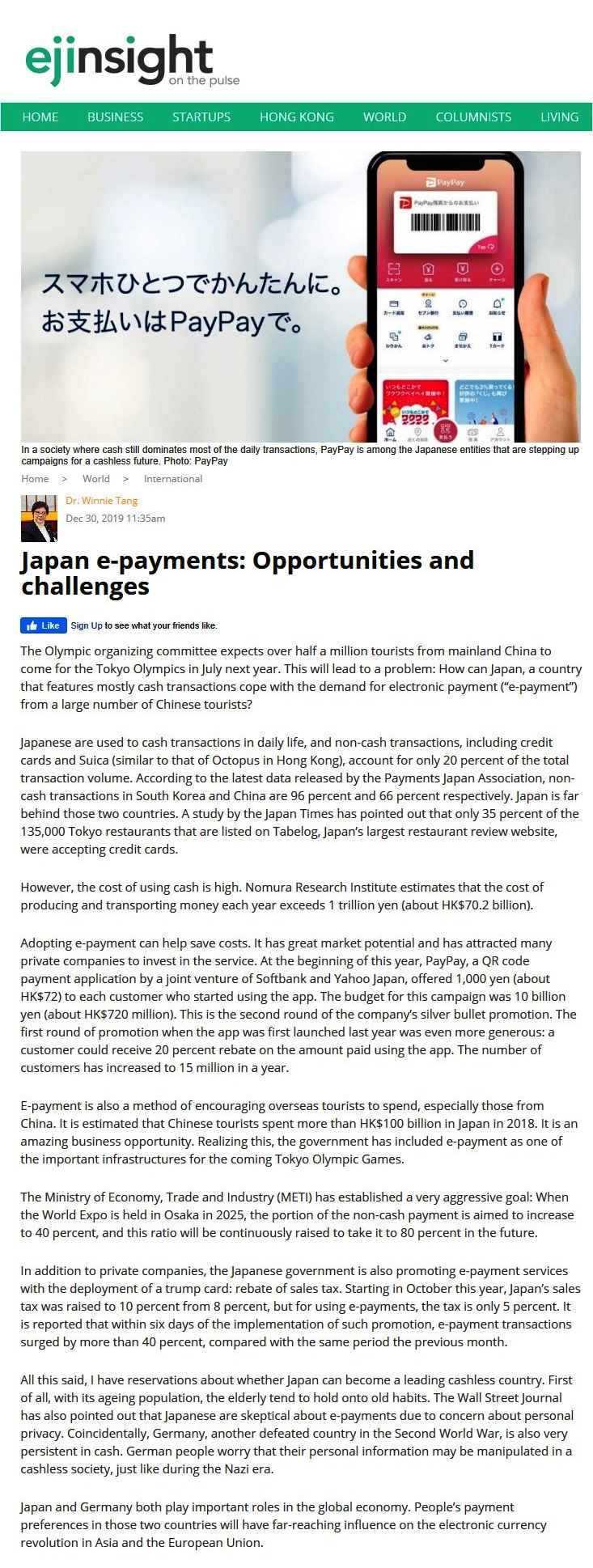網上版請按此

Japan e-payments: Opportunities and challenges
The Olympic organizing committee expects over half a million tourists from mainland China to come for the Tokyo Olympics in July next year. This will lead to a problem: How can Japan, a country that features mostly cash transactions cope with the demand for electronic payment ("e-payment") from a large number of Chinese tourists?
Japanese are used to cash transactions in daily life, and non-cash transactions, including credit cards and Suica (similar to that of Octopus in Hong Kong), account for only 20 percent of the total transaction volume. According to the latest data released by the Payments Japan Association, non-cash transactions in South Korea and China are 96 percent and 66 percent respectively. Japan is far behind those two countries. A study by the Japan Times has pointed out that only 35 percent of the 135,000 Tokyo restaurants that are listed on Tabelog, Japan's largest restaurant review website, were accepting credit cards.
However, the cost of using cash is high. Nomura Research Institute estimates that the cost of producing and transporting money each year exceeds 1 trillion yen (about HK$70.2 billion).
Adopting e-payment can help save costs. It has great market potential and has attracted many private companies to invest in the service. At the beginning of this year, PayPay, a QR code payment application by a joint venture of Softbank and Yahoo Japan, offered 1,000 yen (about HK$72) to each customer who started using the app. The budget for this campaign was 10 billion yen (about HK$720 million). This is the second round of the company's silver bullet promotion. The first round of promotion when the app was first launched last year was even more generous: a customer could receive 20 percent rebate on the amount paid using the app. The number of customers has increased to 15 million in a year.
E-payment is also a method of encouraging overseas tourists to spend, especially those from China. It is estimated that Chinese tourists spent more than HK$100 billion in Japan in 2018. It is an amazing business opportunity. Realizing this, the government has included e-payment as one of the important infrastructures for the coming Tokyo Olympic Games.
The Ministry of Economy, Trade and Industry (METI) has established a very aggressive goal: When the World Expo is held in Osaka in 2025, the portion of the non-cash payment is aimed to increase to 40 percent, and this ratio will be continuously raised to take it to 80 percent in the future.
In addition to private companies, the Japanese government is also promoting e-payment services with the deployment of a trump card: rebate of sales tax. Starting in October this year, Japan's sales tax was raised to 10 percent from 8 percent, but for using e-payments, the tax is only 5 percent. It is reported that within six days of the implementation of such promotion, e-payment transactions surged by more than 40 percent, compared with the same period the previous month.
All this said, I have reservations about whether Japan can become a leading cashless country. First of all, with its ageing population, the elderly tend to hold onto old habits. The Wall Street Journal has also pointed out that Japanese are skeptical about e-payments due to concern about personal privacy. Coincidentally, Germany, another defeated country in the Second World War, is also very persistent in cash. German people worry that their personal information may be manipulated in a cashless society, just like during the Nazi era.
Japan and Germany both play important roles in the global economy. People's payment preferences in those two countries will have far-reaching influence on the electronic currency revolution in Asia and the European Union.
Dr. Winnie Tang
Adjunct Professor, Department of Computer Science, Faculty of Engineering and Faculty of Architecture, The University of Hong Kong